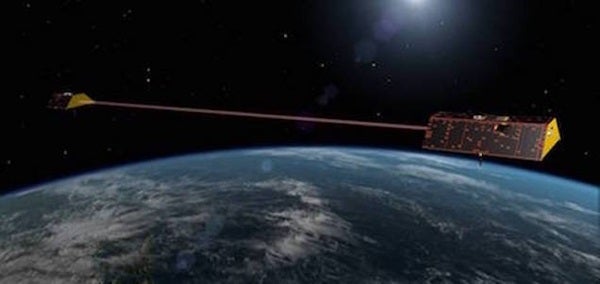NASA and the German Research Centre for Geosciences (GFZ) have teamed up to launch the Gravity Recovery and Climate Experiment Follow-On (GRACE-FO) mission, a paired spacecraft duo that will monitor the ever-changing distribution of Earth’s water and ice. The mission, which is currently in its final stages of preparation, is set to launch from Vandenberg Air Force Base on a SpaceX Falcon 9 rocket as early as May 19.
GRACE-FO is following in the footsteps of its parent mission, GRACE, which spent 15 years tracking the distribution of mass within our oceans, ice sheets, atmosphere, and below Earth’s surface. By continuing to monitor changes in water allocation, researchers will gain additional insight into climate trends, the impact of certain human activities, and water resource management.
“Water is critical to every aspect of life on Earth – for health, for agriculture, for maintaining our way of living,” said the director of NASA’s Jet Propulsion Laboratory (JPL) and GRACE-FO science lead, Michael Watkins, in a press release. “You can’t manage it well until you can measure it. GRACE-FO provides a unique way to measure water in many of its phases, allowing us to manage water resources more effectively.”
Like GRACE, GRACE-FO is made up of two identical satellites that will orbit Earth in tandem at an altitude of about 305 miles (490 kilometers). With 137 miles (220 kilometers) between the two satellites, they will continuously send microwave signals back and forth to keep an extremely accurate log of the distances between them. Since the massive weight of Earth’s water and ice deposits increases the local gravity above them, when the satellites fly over these large masses, the gravitational pull on the closer satellite will be stronger, creating a larger separation between the two orbiting craft. The instruments on GRACE-FO are so precise they will be able to detect any changes in this separation larger than the thickness of a human hair. Over the course of GRACE-FO’s five-year mission, the minute changes in these measurements will allow researchers to create monthly local gravity maps to help them study the migration of water in Earth’s oceans, ice sheets, atmosphere, and even underneath the surface.
“When water is underground, it’s impossible to directly observe from space. There’s no picture you can take or radar you can bounce off the surface to measure changes in that deep water,” Watkins said. “But it has mass, and GRACE-FO is almost the only way we have of observing it on large scales. Similarly, tracking changes in the total mass of the polar ice sheets is also very difficult, but GRACE-FO essentially puts a ‘scale’ under them to track their changes over time.”
The variations in water distribution logged by GRACE-FO’s predecessor, GRACE, contributed to numerous revelations about the state of our planet. It improved predictions for the rise and fall of sea levels by recording the gradual shrinkage of mountain glaciers and the Antarctic and Greenland ice sheets, and also advanced climate and weather projections by tracking changes to atmospheric temperatures and deep ocean currents. Closer to home, the mission monitored variations in soil moisture, surface water, and the groundwater that lies in aquifers, enabling researchers to estimate our land’s total capacity for storing water.
GRACE-FO will succeed its parent mission and continue to track what is touted as a major building block of life. The search for water molecules on distant exoplanets might be all the hype right now, but GRACE-FO and its critical research will continue to make sure all is well on the home front.










